How to Build and Implement an Effective Total Rewards Strategy?
Learn what a Total Rewards Strategy is, why it matters, its key components, how to build, implement, and update it, plus common challenges and solutions.
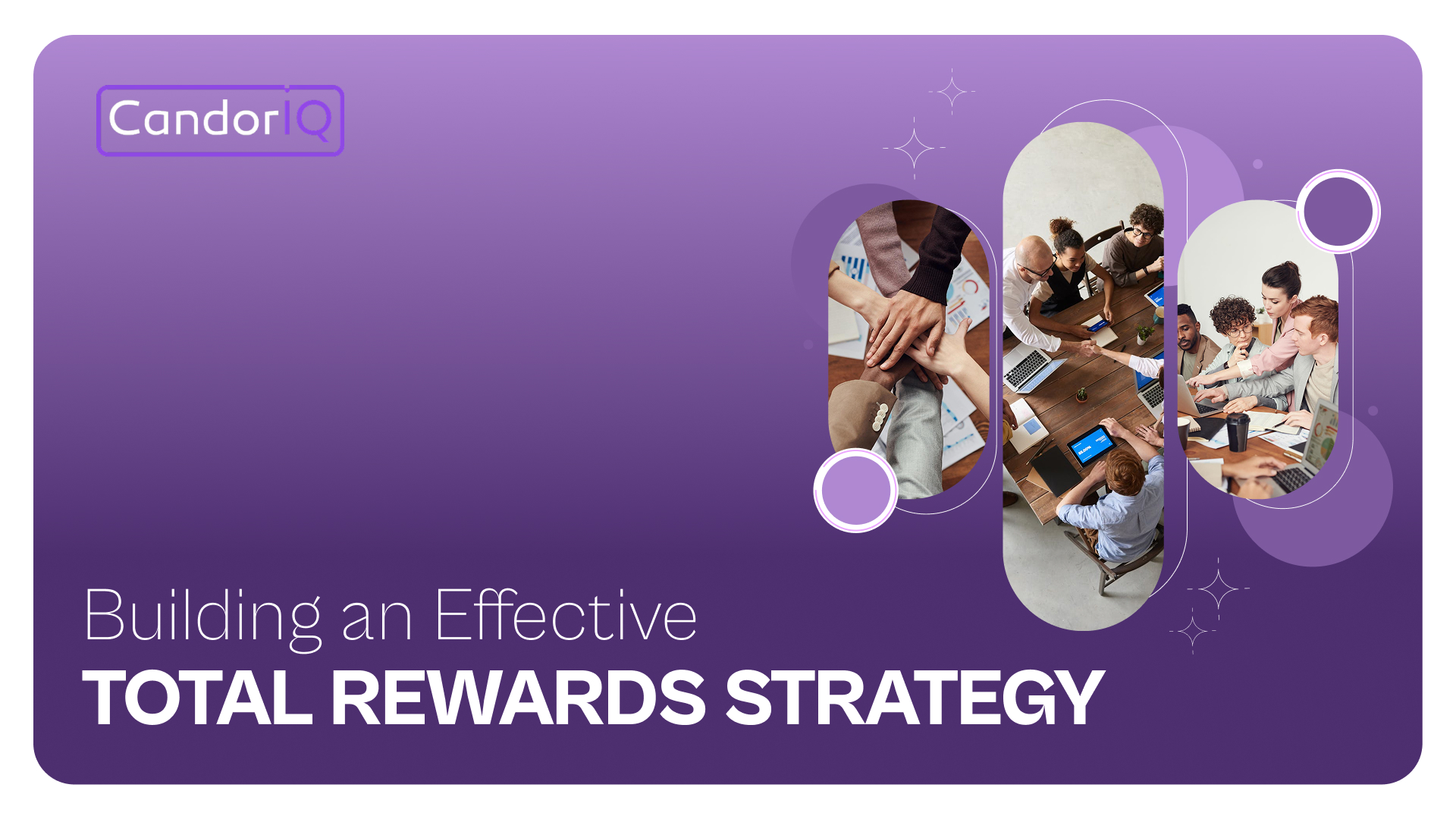
Top talent today wants more than just a paycheck; they want to feel valued and supported for the long run. And if you’re trying to retain great people while managing rapid growth, you’ve probably felt just how overwhelming that can get.
We get it—juggling compensation plans, scattered spreadsheets, and one-off recognition efforts can quickly turn chaotic. That’s why having a clear and flexible Total Rewards Strategy is so important, one that grows with your team and company goals.
In this guide, we’ll walk you through how to build the right team structure and create a rewards strategy that supports your people, aligns with your business objectives, and evolves with your company.
TL;DR
- Definition: Total Rewards includes pay, benefits, flexibility, development, and recognition, aligned to employee needs and business goals.
- Business impact: A strong strategy drives retention and performance by connecting rewards to company values and making employees feel valued.
- Core components: Key elements include compensation, benefits, work-life balance, career growth, and recognition programs.
- Strategic approach: Start with employee feedback, tie rewards to business priorities, benchmark against the market, and communicate clearly.
- Common challenges: Internal equity, benefit complexity, and market shifts can be tackled with data-driven tools and regular strategy updates.
What is a Total Rewards Strategy?
A Total Rewards Strategy is how a company says, “We value you”—not just with pay, but with meaningful benefits, career growth, flexibility, and appreciation that align with both employee needs and business goals.
For today’s workforce, especially in competitive sectors like tech or SaaS, this kind of alignment can drive higher retention, better engagement, and a workplace culture where people feel recognized, supported, and motivated to grow.
That level of impact takes intentional planning through a Total Rewards Strategy that’s built around what truly matters to your people.
Importance of a Total Rewards Strategy
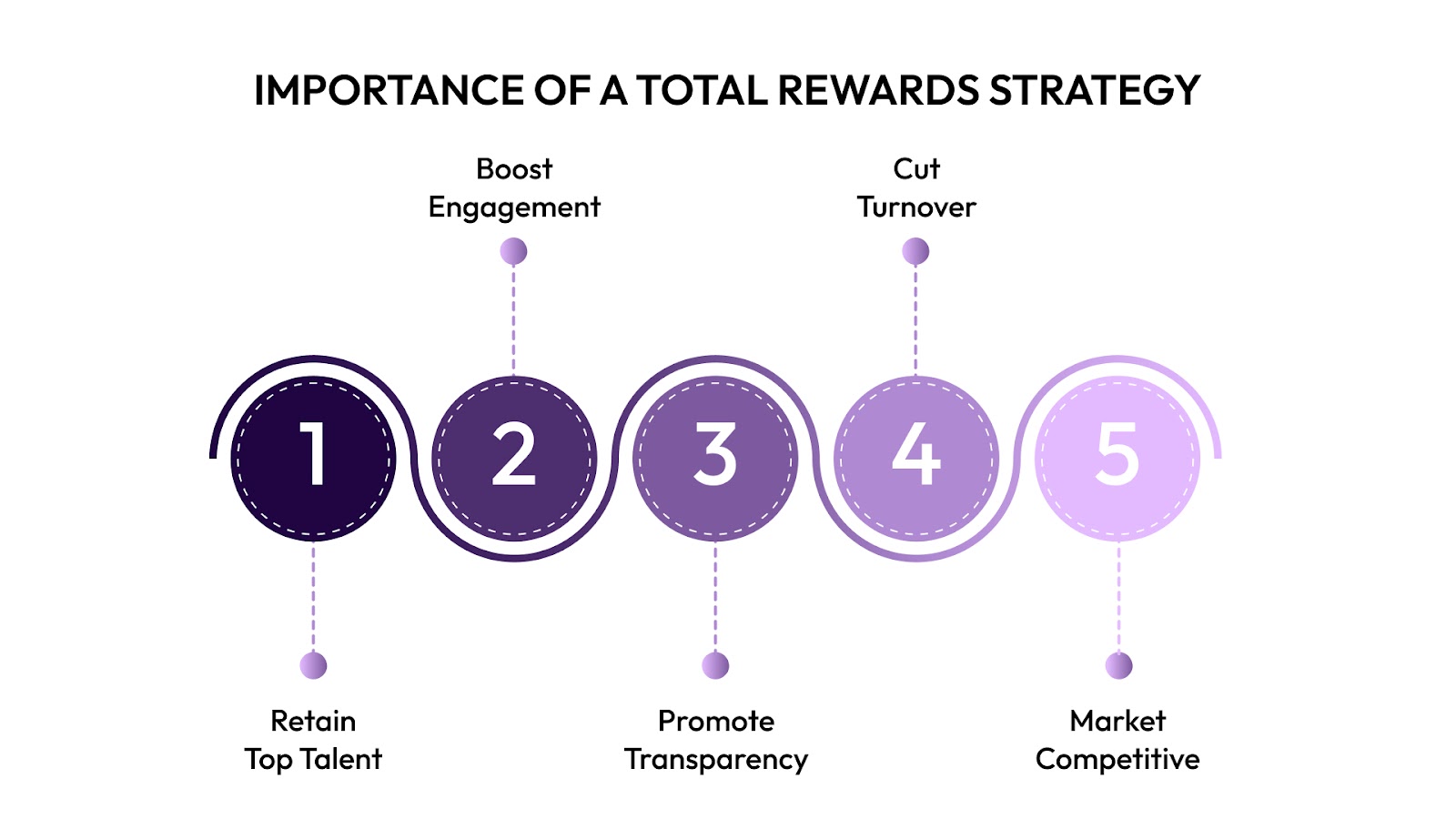
A Total Rewards Strategy plays a vital role in any organization, but it’s especially important in competitive industries like technology and SaaS. For U.S.-based companies seeking to attract and retain top talent, a well-planned rewards strategy can be the edge that sets them apart. Here’s why it matters:
- Attract and Retain Top Talent: A well-rounded Total Rewards Strategy, combining pay, benefits, growth, and flexibility, helps companies stand out and secure high-performing talent.
- Boost Engagement and Satisfaction: When employees feel valued through fair pay, wellness support, and career growth, they’re more motivated, productive, and satisfied at work.
- Promote Transparency and Equity: A fair and inclusive rewards approach encourages trust and supports DEI goals by ensuring all employees feel respected and fairly compensated.
- Reduce Turnover Costs: A thoughtful rewards strategy builds loyalty and reduces the high costs and disruptions caused by employee turnover.
- Stay Market Competitive: Adapting rewards to evolving trends, like remote work, wellness, or learning, keeps organizations attractive to today’s effective workforce.
Once you recognize the value of a Total Rewards Strategy, the next step is to understand what it's actually made of.
What are the Components of Total Rewards?
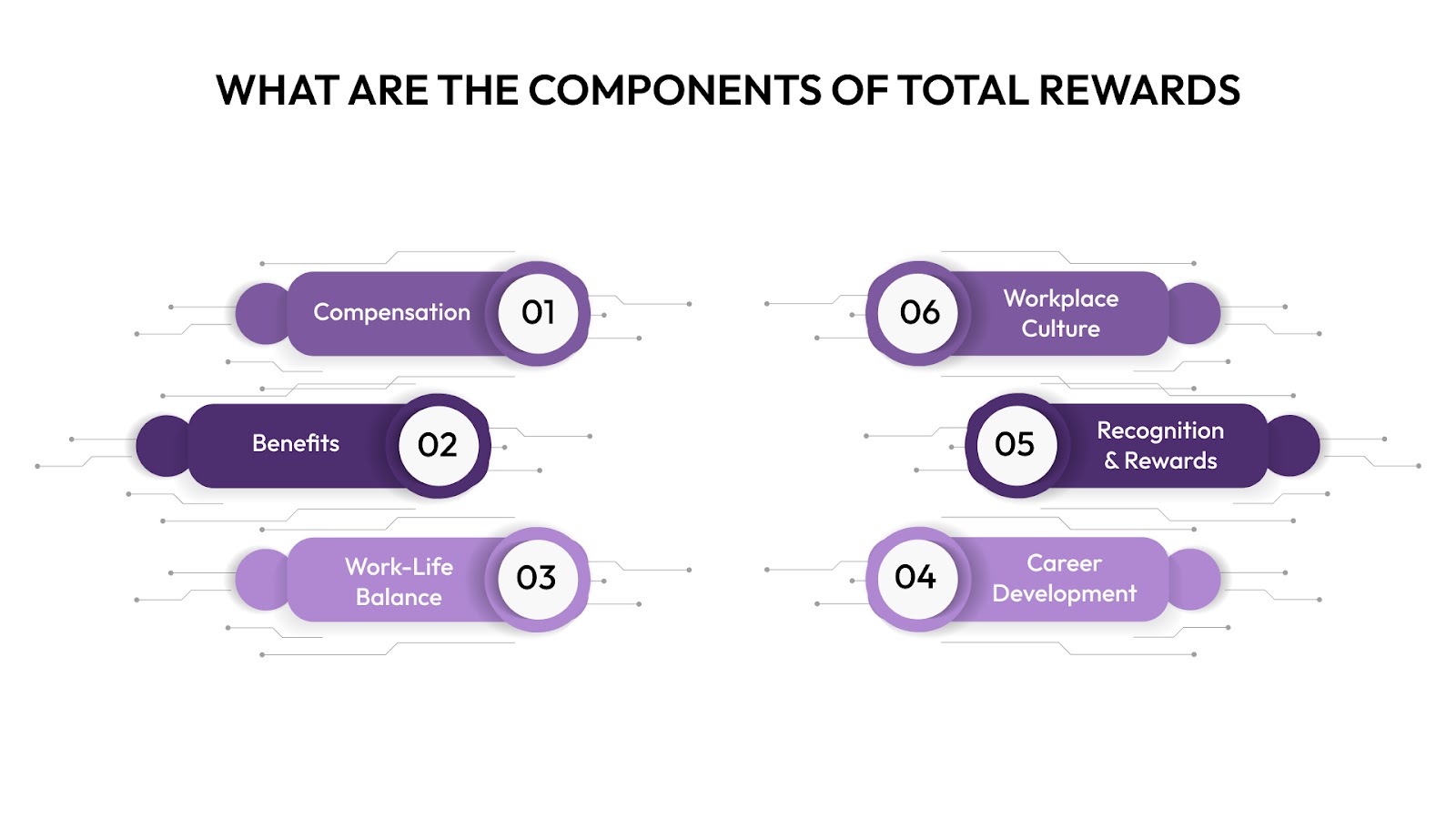
A Total Rewards Strategy covers all the ways a company supports, rewards, and recognizes its people, but through a broader package that speaks to what employees truly value. When thoughtfully designed, each part of this package helps build a strong competitive edge.
Before you start building a strategy, it’s important to understand the key building blocks. Here’s a breakdown of the six core components that form a complete and competitive Total Rewards Strategy:
Compensation
Compensation forms the backbone of any rewards strategy, offering employees a sense of financial stability and recognition for their contributions. It includes:
- Base Salary: A strong rewards strategy starts with a fair, competitive base salary. For U.S. tech companies, aligning pay with market rates and ensuring internal equity helps employees feel valued.
- Incentives and Variable Pay: Performance-based bonuses, commissions, and stock options motivate employees and align their efforts with business goals.
- Equity and Stock Options: Offering equity, RSUs, or stock bonuses gives employees a stake in the company’s growth, boosting loyalty and long-term commitment.
Benefits
Benefits provide essential support for employees' health, security, and overall well-being, both inside and outside the workplace. It includes:
- Health and Wellness: Comprehensive benefits like medical, dental, vision, mental health support, fitness programs, and preventive care show employees their well-being is a priority.
- Retirement Plans: 401(k)s, pensions, and employer matching programs help employees build financial security. It's an increasingly valued benefit among younger, financially aware professionals.
- Life Insurance and Disability Coverage: Providing life and disability insurance ensures employees and their families are protected against unexpected challenges, reinforcing a culture of care and support.
Work-Life Balance
Work-life balance initiatives enable employees to manage their personal responsibilities while maintaining productivity and engagement at work. It includes:
- Paid Time Off (PTO): Time away from work through vacation, sick leave, and holidays helps employees recharge and stay productive. Many companies now offer flexible or unlimited PTO to meet varied needs.
- Flexible Work Arrangements: Remote, hybrid, and flexible schedules empower employees to balance work and life on their terms. It is now a standard expectation, not just a perk.
- Parental Leave: Gender-inclusive paid parental leave reflects a company’s support for family life, showing commitment to employees beyond their job titles.
Career Development
Career development opportunities show employees that the company is invested in their growth and long-term success. It includes:
- Learning and Development: Ongoing learning through courses, certifications, or tuition support keeps employees growing and shows the company’s commitment to their development.
- Mentorship and Coaching: Mentorship, whether structured or informal, offers guidance and support, helping employees feel connected and purposeful in their careers.
- Promotions and Career Pathing: Clear growth paths, consistent feedback, and transparent promotions help employees envision a future within the company and stay engaged.
Recognition and Rewards
Recognition and rewards boost morale and reinforce positive behaviors by celebrating employee achievements. It includes:
- Employee Recognition Programs: Celebrating achievements through awards, shout-outs, or events boosts morale and reinforces a culture of appreciation.
- Spot Bonuses and Non-Monetary Rewards: Unexpected perks, like bonuses, extra time off, or thoughtful gifts, make employees feel valued beyond formal evaluations.
- Peer Recognition: Empowering employees to recognize each other encourages camaraderie and strengthens a sense of shared purpose.
Workplace Culture and Environment
A strong culture makes people feel like they belong and helps them connect with your company’s mission. It includes:
- Company Values and Mission: A clear mission and inclusive culture attract employees who align with the company’s purpose, often holding equal weight to compensation.
- Employee Experience: Everyday interactions shape workplace culture. When employees feel heard, supported, and part of a positive environment, they’re more engaged and productive.
Knowing the key components is just one part of the puzzle. The real impact occurs when those elements are thoughtfully combined into a strategy that aligns with your organization’s goals and people.
Also Read: Mastering Employee Pay Growth Modeling Techniques
Creating a Total Rewards Strategy
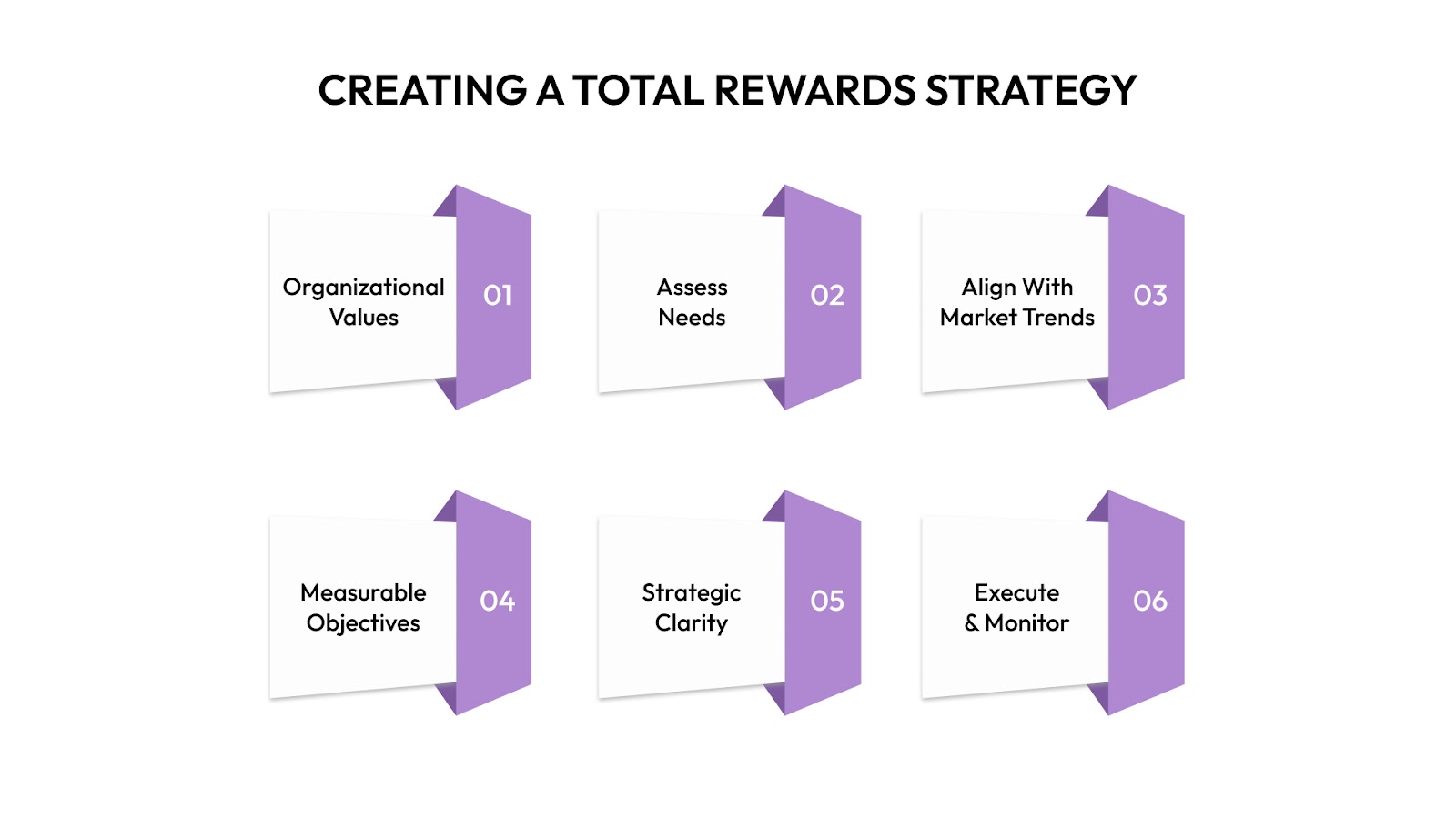
Building a Total Rewards Strategy is about more than offering good pay and a few perks. It’s about making thoughtful choices that support your employees and help your business grow.
A well-designed strategy aligns the company's objectives with what employees truly value. It creates a work environment where people feel motivated, supported, and part of something meaningful.
Here’s a step-by-step look at how to create a strategy that actually works:
1. Define Your Organizational Goals and Values
Start by grounding your Total Rewards Strategy in your company’s core mission, values, and culture. If your business thrives on innovation, consider offering equity or career growth opportunities. And, if work-life balance is a priority, build in flexibility and remote options.
2. Conduct a Thorough Needs Assessment
To build a strategy that truly resonates, you need to understand what your employees value most. Use surveys, focus groups, or direct feedback to learn about their preferences around compensation, flexibility, and career growth.
Designing your rewards around what employees actually want makes your program more practical and engaging for everyone. The key areas to explore include:
- Compensation: Are salaries and benefits meeting expectations and market standards?
- Work-Life Balance: Do employees want more flexibility or remote work options?
- Career Development: Are they seeking growth opportunities or stability?
3. Align the Strategy with Market Data and Trends
Revisit the key Total Rewards components and design a package that balances employee needs with business priorities.
To stay competitive, regularly benchmark your compensation and benefits against industry standards. Benchmarking means comparing your offerings, like salaries or equity plans, with what similar companies provide.
Tools like compensation surveys and pay band modeling software can help you see if you’re ahead, behind, or right on target. This matters more than ever in industries where skilled talent is in high demand.
Also, keep in mind that different employee groups may prioritize other things. Gen Z may prioritize flexibility and career growth, while Gen X may focus on retirement or healthcare benefits. Let your data guide those decisions.
4. Set Clear and Measurable Objectives
Define what success looks like so you can track progress and adjust when needed.
Metrics like retention, engagement, and market competitiveness help you evaluate whether your strategy is working and where improvements are needed. Common goals to measure include:
- Retention Rates: Are employees staying longer?
- Engagement Scores: Are people motivated and committed?
- Industry Positioning: Is your rewards package keeping you ahead in the talent game?
For instance, a 10% improvement in engagement scores over 6 months can indicate program success.
5. Communicate the Strategy Clearly
Even the best-designed rewards program won’t deliver results if employees don’t understand it. Communicate your Total Rewards Strategy in a clear and transparent manner, through onboarding, benefits overviews, and one-on-one check-ins. This way, employees can see the full value of what they’re getting.
Be sure to explain not just the what, but also the why behind your offerings. When employees understand the full picture, from salary and bonuses to health benefits and flexibility, it builds trust and appreciation.
6. Implement and Continuously Monitor the Strategy
Roll out your strategy thoughtfully and closely monitor its performance. Start small if needed, test with a pilot group, then scale. Once live, collect feedback, monitor key outcomes, and be ready to adapt as your company grows or market expectations shift.
A Total Rewards Strategy isn’t static. It should evolve with your workforce, business goals, and the broader talent landscape to stay relevant and impactful.
As your strategy evolves, so does the need to implement those changes in a way that resonates with your team. That means thinking carefully about how you update, communicate, and roll out your refreshed Total Rewards approach.
CandorIQ helps you build a scalable, data-driven total rewards team structure, from pay band modeling to offer generation, all in one platform.
Updating & Implementing Your New Total Rewards Strategy

Once you’ve thoughtfully built your Total Rewards Strategy, the next step is bringing it to life across your organization. This involves updating your current offerings, rolling out the new plan, and ensuring that everyone understands what’s changing and why.
A smooth, well-communicated transition is key to building trust and making the strategy part of your company’s everyday culture.
Here’s a step-by-step guide to help you implement and embed your Total Rewards Strategy in a way that supports both business goals and employee expectations:
1. Conduct a Review of the Existing Strategy
Before making any changes, assess the current state of your Total Rewards Strategy. Start by identifying gaps using employee feedback, market data, and business goals.
Are your salaries competitive? Do your benefits reflect what employees actually want, like mental health support or remote flexibility? Hearing directly from your people through surveys or focus groups helps ensure you’re solving the right problems from the start.
2. Communicate Changes Clearly and Transparently
A successful rollout begins with clear and honest communication about what’s changing and why. Build a communication plan that reaches everyone, whether it’s through emails, intranet updates, or live town halls.
Focus on what matters most to employees, such as improved pay, better benefits, and more flexibility, and ensure they understand the full value of the new package. Support this with educational sessions and FAQs to guide them through any complex changes, such as stock options or retirement plans. Use multiple channels so that no one is left out of the loop.
3. Pilot the New Strategy with a Small Group
Choose a team or department that can give specific, thoughtful feedback. Track their experience using surveys and feedback tools to monitor engagement and satisfaction. If something isn’t landing right, whether it’s compensation levels, clarity, or access to benefits, adjust as needed before launching the full program.
For instance, a pilot with the Engineering team revealed confusion about stock options, prompting an FAQ session before the org-wide launch.
4. Roll Out the New Strategy Organization-Wide
Once the pilot is refined, it’s time to bring the new strategy to everyone. Set a clear rollout timeline so employees know what to expect and when. Update your HR and payroll systems to reflect the new compensation structure, benefits, and perks.
Equip managers and HR teams with the right training so they can guide employees through the transition. Keep communication open and ongoing so employees feel supported as the new strategy takes shape.
5. Monitor the Effectiveness of the Strategy
Implementation doesn’t stop once the plan is live; monitoring is crucial to ensuring it works effectively. Are people happier with their compensation and benefits? Are they staying longer or showing more enthusiasm in their roles? Regular feedback will help you understand what’s working and where adjustments may be needed.
6. Encourage a Culture of Continuous Improvement
A great Total Rewards Strategy is never one-and-done; it should grow as your people and business evolve. Make it a habit to review your strategy at least once a year. Whether it’s new learning opportunities, added flexibility, or shifting benefit preferences, staying responsive helps you build a stronger, more engaged workforce over time.
Designing a strategy that keeps up with changing needs isn’t always straightforward. There are common hurdles along the way.
Also Read: Compensation Management Software Guide for HR Teams in 2025
Challenges & Solutions to Building a Total Rewards Strategy
Creating an effective Total Rewards Strategy isn’t always straightforward, especially for U.S.-based companies in the tech, SaaS, and startup sectors. These organizations face constant pressure to stay competitive in the talent market while also being fair and financially sustainable.
Here are some of the most common challenges companies face when designing a Total Rewards Strategy, along with practical solutions:
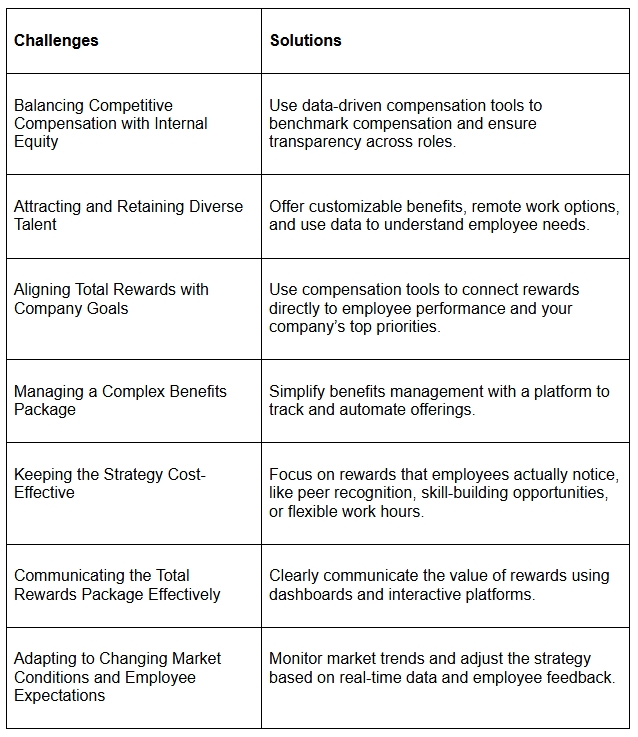
Even the best-designed Total Rewards Strategy needs the right systems to stay consistent and scalable. With CandorIQ, you can simplify compensation planning, align rewards with performance, and reduce manual tasks across your total rewards team.
Final Thoughts
Creating a Total Rewards Strategy and the right team to support it is one of the best investments you can make in your people. It’s what helps you attract top talent, reduce turnover, and build a culture of trust, transparency, and shared success.
But pulling compensation planning, equity, benefits, and communications can be complex, especially as your company scales. That’s where a platform like CandorIQ can make a real difference.
It brings all your Total Rewards tools together in one place, from pay band design and workforce analytics to offer generation and benchmarking insights.
If you're ready to bring structure, clarity, and momentum to your Total Rewards Strategy, book your demo with CandorIQ today.
Also Read: Understanding Performance-Based Compensation: Pros and Cons
FAQs
Q1. Why is it important to have a defined Total Rewards team structure?
A1. Having a clear team structure brings focus, accountability, and efficiency, especially during compensation reviews, offer planning, or benefits updates. It reduces dependency on spreadsheets, speeds up decision-making, and ensures consistency as your company grows.
Q2. What’s the difference between a Total Rewards Manager and a Compensation Manager?
A2. A Total Rewards Manager looks after the full package, such as salary, equity, benefits, recognition, and more, while a Compensation Manager specifically focuses on pay structures, market benchmarking, and salary reviews. In smaller organizations, one person might wear both hats.
Q3. What are the key responsibilities of a Total Rewards team?
A3. The Total Rewards team handles everything from designing compensation strategy and managing salary bands to planning equity and overseeing employee benefits. They also lead communication around rewards to make sure everything aligns with market data, internal fairness, and company goals.
Q4. How does technology support the Total Rewards team structure?
4. Modern platforms simplify the process by automating merit cycles, modeling pay bands, generating offers, and tracking equity in one place. This helps lean teams work more efficiently and scale rewards without getting stuck in manual tasks.


